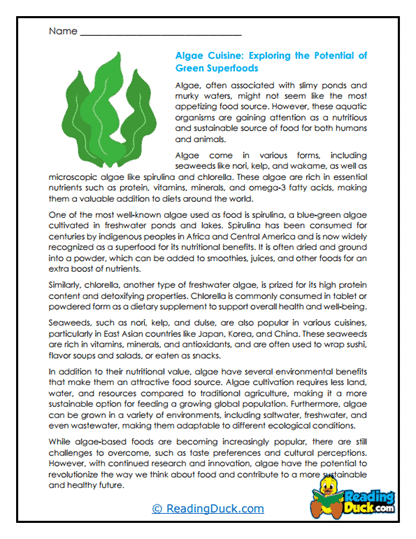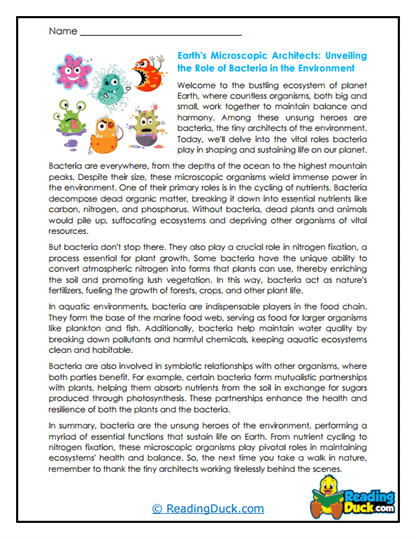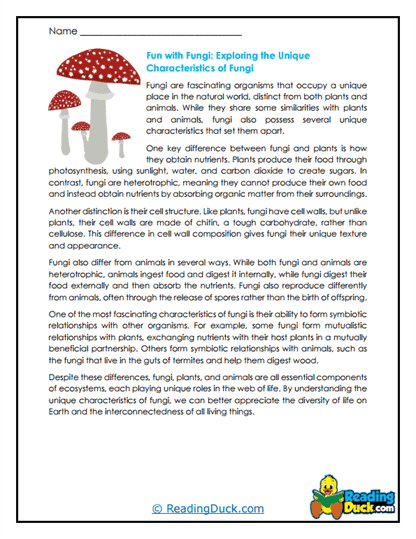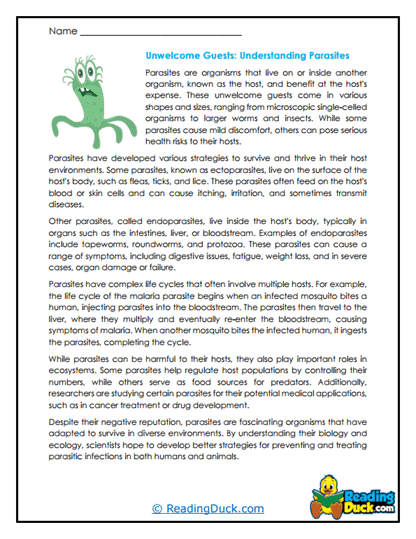Microbiology Worksheets
About Our Microbiology Worksheets
Our Microbiology worksheets offer an engaging and comprehensive exploration of the microscopic world that plays a crucial role in various aspects of life. As a subtopic under the broader category of Science: Biology, this collection delves into the fascinating world of microorganisms and their impact on health, the environment, and industry. The worksheets are designed to help students understand the structure, function, and significance of different microorganisms, as well as the roles they play in disease, ecology, and biotechnology. Each worksheet set within this collection is crafted to make learning about microbiology both educational and enjoyable.
This collection contains several worksheet sets, each focusing on different aspects of microbiology. The collection is divided into the following categories: Algae, Antibiotics, Bacteria, Fungi, Immunology, Medical Microbiology, Parasites, Pathogens, Protists, and Viruses. Each worksheet set includes:
- Multiple Choice Questions: These questions assess students' comprehension of the reading material, ensuring they grasp the key concepts and details presented.
- Short Answer Questions: This section prompts students to articulate their understanding in their own words, reinforcing their knowledge and improving their ability to communicate scientific information effectively.
- Open-Ended Questions: These questions encourage students to share their personal thoughts, opinions, and reflections on the material, fostering deeper engagement and critical thinking.
Each worksheet is accompanied by an answer key, making it easy for educators and parents to review students' work. The worksheets are available in PDF format, ensuring they can be easily viewed electronically, downloaded, and printed for use in various educational settings.
Exploring Microbiology: The Invisible World that Shapes Our Lives
Microbiology is the study of microorganisms, tiny life forms that are invisible to the naked eye but have a profound impact on the world around us. Microorganisms include bacteria, viruses, fungi, protists, and algae, among others. They are involved in processes ranging from nutrient cycling and food production to causing diseases and producing antibiotics. When introducing students to microbiology, it’s essential to convey the diversity, complexity, and significance of these organisms. Here’s a detailed breakdown of the key aspects of microbiology covered in this collection:
Algae: The Photosynthetic Microorganisms: Algae are simple, photosynthetic organisms found in various aquatic environments.
- Diversity of Algae: Students will explore the different types of algae, including green algae, red algae, and brown algae. These organisms are crucial for producing oxygen and forming the base of aquatic food chains.
- Algae in Biotechnology: Algae are used in the production of biofuels, food supplements, and pharmaceuticals. Understanding the applications of algae in biotechnology helps students appreciate their importance beyond natural ecosystems.
Antibiotics: The Fight Against Bacterial Infections: Antibiotics are substances that kill or inhibit the growth of bacteria.
- Discovery and Mechanism of Action: Students will learn about the discovery of antibiotics, such as penicillin, and how these drugs work to combat bacterial infections.
- Antibiotic Resistance: The misuse and overuse of antibiotics have led to the emergence of antibiotic-resistant bacteria. Students will explore the causes and consequences of antibiotic resistance and the importance of responsible antibiotic use.
Bacteria: The Ubiquitous Microorganisms: Bacteria are single-celled organisms found in virtually every environment on Earth.
- Structure and Function of Bacteria: Students will explore the structure of bacterial cells, including the cell wall, plasma membrane, and genetic material. They will learn about the different shapes and arrangements of bacteria, such as cocci, bacilli, and spirilla.
- Beneficial and Harmful Bacteria: While some bacteria cause diseases, many play essential roles in processes like nitrogen fixation, decomposition, and fermentation. Understanding the dual roles of bacteria helps students appreciate their importance in both health and the environment.
Fungi: Decomposers and Symbionts: Fungi are a diverse group of organisms that include yeasts, molds, and mushrooms.
- Fungal Structure and Reproduction: Students will learn about the structure of fungi, including hyphae, mycelium, and spores. They will explore how fungi reproduce through both sexual and asexual means.
- Fungi in Medicine and Industry: Fungi are used in the production of antibiotics, such as penicillin, and in the fermentation of products like bread and beer. Students will explore the applications of fungi in medicine and industry, as well as their role in decomposing organic matter and recycling nutrients in ecosystems.
Immunology: The Body’s Defense Against Microbes: Immunology is the study of the immune system, the body’s defense mechanism against infections.
- Innate and Adaptive Immunity: Students will explore the components of the immune system, including white blood cells, antibodies, and lymph nodes. They will learn about the differences between innate (nonspecific) and adaptive (specific) immunity.
- Vaccines and Immunization: Vaccines are a crucial tool in preventing infectious diseases. Students will learn about how vaccines work, the concept of herd immunity, and the role of immunization in public health.
Medical Microbiology: Microorganisms and Human Health: Medical microbiology focuses on the study of microorganisms that cause diseases in humans.
- Pathogens and Disease: Students will explore the types of pathogens, including bacteria, viruses, fungi, and parasites, and how they cause diseases. They will learn about the transmission, symptoms, and treatment of various infectious diseases.
- Diagnostic Techniques: Medical microbiologists use techniques like microscopy, culturing, and molecular methods to diagnose infections. Understanding these techniques helps students appreciate the challenges and advances in diagnosing and treating infectious diseases.
Parasites: Organisms That Depend on a Host: Parasites are organisms that live on or inside a host organism, often causing harm.
- Types of Parasites: Students will explore the different types of parasites, including protozoa, helminths (worms), and ectoparasites like lice and ticks. They will learn about the life cycles of parasites and how they spread from host to host.
- Impact of Parasitic Infections: Parasitic infections, such as malaria and schistosomiasis, have significant health impacts, especially in developing countries. Understanding the global burden of parasitic diseases helps students appreciate the importance of public health measures and research.
Pathogens: Microbes That Cause Disease: Pathogens are microorganisms that cause diseases in humans, animals, or plants.
- Virulence Factors: Students will learn about the mechanisms pathogens use to infect hosts, such as toxins, enzymes, and adhesion factors. Understanding virulence factors helps students grasp how certain microbes are more likely to cause disease.
- Host-Pathogen Interactions: The interaction between pathogens and the host’s immune system is complex and can determine the outcome of an infection. Students will explore how the body defends itself against pathogens and how some microbes evade the immune system.
Protists: The Diverse Kingdom: Protists are a diverse group of eukaryotic microorganisms that include algae, protozoa, and slime molds.
- Characteristics of Protists: Students will explore the diversity of protists, including their various modes of movement, such as cilia, flagella, and pseudopodia. They will learn about the ecological roles of protists in aquatic environments and their importance in food chains.
- Protists and Disease: Some protists, like Plasmodium (which causes malaria) and Giardia (which causes giardiasis), are human pathogens. Understanding the role of protists in disease helps students appreciate their significance in global health.
Viruses: The Tiny Invaders: Viruses are non-living entities that can only replicate inside a host cell.
- Structure and Replication of Viruses: Students will learn about the structure of viruses, including their genetic material (DNA or RNA) and protein coat (capsid). They will explore how viruses infect host cells and use the host’s machinery to replicate.
- Impact of Viral Infections: Viral infections, such as the flu, HIV, and COVID-19, have significant health, social, and economic impacts. Understanding how viruses spread and cause disease helps students appreciate the importance of public health measures, such as vaccination and quarantine.
By studying these aspects of microbiology, students gain a comprehensive understanding of the microorganisms that impact our lives in countless ways. The worksheets help break down complex concepts into engaging and accessible material, fostering curiosity and a deeper appreciation for the invisible world of microbes.
How Students Can Use These Worksheets
Here are five tangible ideas on how teachers and parents can use these Microbiology worksheets in school or in a homeschool setup in effective, productive, and creative ways:
- Microbial Cultures Project: Students can grow bacterial or fungal cultures on agar plates as part of a hands-on lab activity. Using the worksheets as a guide, they can document the growth patterns, identify different types of colonies, and discuss the factors that influence microbial growth. This project allows students to observe microorganisms directly and apply their knowledge in a practical setting.
- Case Studies on Infectious Diseases: Use the worksheets to introduce students to real-world case studies of infectious diseases caused by bacteria, viruses, fungi, or parasites. Students can research the history, symptoms, treatment, and impact of these diseases, then present their findings to the class. This activity fosters critical thinking and helps students connect microbiology to current events and global health issues.
- Create a Microbe Profile: Assign students to research and create a detailed profile of a specific microbe, such as a virus, bacterium, or protist. They can use the worksheets to structure their research and include information on the microbe’s structure, habitat, role in the environment, and its effects on human health. This project encourages independent research and enhances students' understanding of microbial diversity.
- Immunology Simulation Game: Organize a classroom game where students role-play as different components of the immune system, such as white blood cells, antibodies, or pathogens. They can use the worksheets to learn about the immune response and apply their knowledge in the game. This interactive approach makes learning about immunology fun and memorable.
- Debate on Antibiotic Resistance: Use the open-ended questions from the worksheets to spark a debate on the issue of antibiotic resistance. Students can research the causes, consequences, and solutions to this growing problem and present their arguments. This activity not only reinforces their understanding of antibiotics but also encourages critical thinking and communication skills.
The Importance of Understanding Microbiology
Understanding microbiology is crucial for students on both an academic and personal level. Academically, it provides a foundation for advanced studies in biology, medicine, environmental science, and biotechnology. It also enhances critical thinking skills as students explore how microorganisms interact with their environment, contribute to human health, and drive biotechnological innovations.
On a personal level, knowledge of microbiology empowers students to make informed decisions about their health and hygiene. Understanding how microbes cause diseases, how vaccines work, and the importance of proper sanitation can lead to healthier lifestyle choices. Additionally, appreciating the beneficial roles of microbes in food production, environmental sustainability, and medicine helps students see the positive impact of these tiny organisms on our world.
Overall, these Microbiology worksheets offer a valuable resource for educators and students alike, providing a detailed and engaging exploration of the fascinating and essential world of microorganisms.









